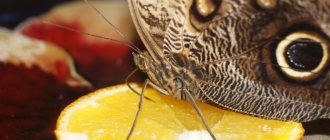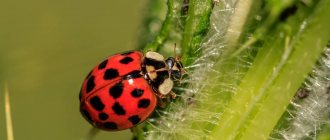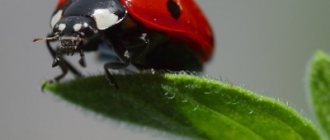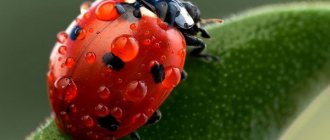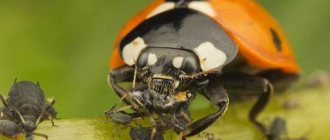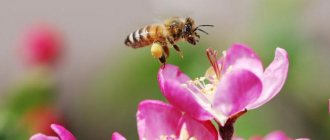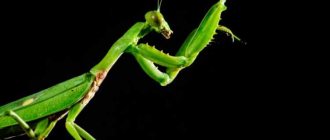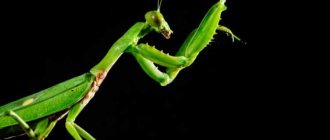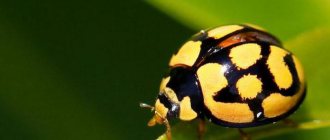Features and habitat of the insect
The ladybug (from the Latin Coccinellidae) is a coleopterous insect of the order of beetles , which lives in almost all corners of the globe, except Antarctica and permafrost zones. In its natural habitat, this insect does not look defenseless - it is a pronounced predator.
The body of Coccinellidae has a hemispherical convex shape. The phase of intensive reproduction and development of beetles begins with the onset of spring and lasts until late autumn. The lifespan of a ladybug ranges from 3-4 months to a year, depending on the climatic conditions of the region and the availability of food.
The seven-spotted ladybird (from the Latin Coccinella septempunctata) is the most numerous and widespread species of the order. It is characterized by a pronounced color of the wings (red-orange tones) and black dots on them. It has a unique method of protection - in case of danger, it releases a characteristically smelling orange liquid. Developed wings enable the insect to fly.
The main enemies of Coccinellidae are spiders and the frogs that feed on them. They are of no interest to birds.
origin of name
The ladybug got its name due to its rich and bright color. In Latin it sounds "coccinellidae" - from "coccineus", which means "scarlet". The popular nickname given to this insect testifies to people’s sympathy for this insect. The Czechs, for example, call it the sun, the Germans call it the bug of the Virgin Mary.
Similar names are used by Latin Americans, who refer to it as St. Anthony's cow.
The exact origin of the Russian-language name is unknown. Some researchers say there may be a connection between the insect's tendency to secrete milk when threatened. In fact, this substance is toxic and is a hemolymph that repels predators. The word “God’s” is a kind of symbol of harmlessness and meekness.
Other scientists believe that these insects got their name because they protect the crop in every possible way by destroying pests.
Nutrition and maintenance
In order to feed a ladybug, you need to know what it eats. Young individuals are very voracious. Ladybugs eat:
- aphids are the main source of food;
- psyllids;
- scale insects;
- scale insects;
- ticks.
Therefore, they can most often be found under the leaves of trees and plants, as well as in crevices of buildings and wooden window blocks.
Transparent glass or plastic containers with a closed top are ideal for home improvement. The best option would be a bottle or food box with a lid. But we should not forget that every living organism requires oxygen for life and development, so small holes must be made in the lid to allow air to enter the container.
The cow's home should be of such a size that it can fly short distances. A twig or any object with an internal hole is perfect as a sleeping place so that the animal can hide there. For variety and beauty, you can add flower petals or grass to the “interior”. It is important to prevent the leaves from rotting and drying in the container , changing them every two days.
It is not recommended to store the glass “house” in places with direct exposure to sunlight, since strong heating of the vessel can lead to detrimental consequences for the insect.
Food for keeping ladybugs at home can be:
Water plays a special role in the nutritional diet of any organism. For convenience, you can place a metal bottle cap in your home and fill it with water. The water level in the drinking bowl should not exceed the height of the beetle's body so that it does not drown. It is enough to feed and water the insect 2-3 times a day, but it is important not to overfeed it. Meals should be taken in small portions.
Where does he live?
Beautiful bugs are distributed across all continents. They populated all zones. The exceptions are areas where the temperature does not exceed 0°C throughout the year and Antarctica.
The insect can be found in all European countries: Great Britain, fragrant in the flowers of Denmark, Sweden, France, Iceland. Germany, Italy, and Poland also sheltered this bright insect. Ladybugs fly over India, Korea, the Islamic Republic, Japan, South and North America, and Mongolia. The distribution area also covers Laos, Myanmar, Indonesia and even Cambodia.
In nature, there are many species of bright representatives of the insect world, their classification is simply huge, and each of them prefers special habitats and each of them has a specific role. Some species settle on plants that have been damaged by aphids. Others can be seen on field and marsh grasses.
Care and caution
The ladybug is small (an adult reaches an average of 0.8−1 cm) and fragile, so any attempt to pick it up or play with it can lead to negative consequences. Precautionary and careful measures when caring for a bug are the following:
- It is better to catch the animal with a net.
- In order to take an insect in your hand, you need to place your finger next to it and wait for it to climb onto it.
- The ideal temperature for life and reproduction of Coccinellidae is considered to be +20 ⁰ C, so it is recommended to avoid hypothermia.
Do not forget that your pet is an insect, so after each contact with it it is recommended to wash your hands thoroughly with soap.
Interesting to know
Folklorists believe that the name of the beetle is directly related to the ancient Slavic pagan goddess of agriculture and fertility Mokosh. The flight of an insect from the finger was accompanied by the well-known request for bread (“fly to heaven, bring me bread”) as a symbol of productivity and prosperity. This explains her divinity.
Ladybugs can sometimes fly to your apartment or house in early to mid-autumn. Most people have a favorable attitude towards these cute insects, despite the fact that by nature they are pronounced predators.
Read on Dacha6.ru:
The best advice is to release the ladybug into the wild, but if it gets sharply cold outside, you can help the insect survive the winter by moving into your apartment.
Take a glass liter jar, put some twigs and sticks on its bottom and carefully transfer the insect into it. Ladybugs should be fed with sugar or honey diluted in water (for these purposes, you can use a folded small piece of gauze or cotton wool dipped in sweet syrup). They will definitely like this delicacy.
After feeding the unexpected guests well and watching them for a while, you should put them to bed. For ladybugs to fall asleep, the temperature must be below room temperature. The ideal place is between the window frames. Place the jar there and cover it loosely with a cloth. The light will not disturb the cows, and the air needed for breathing will calmly penetrate inside.
Ladybugs eat:
- sweet water with sugar;
- sweet water with diluted honey;
- raisin;
- pieces of ripe apples;
- lettuce
You need to feed very little 2 times a day. Be sure to provide some clean water in addition to food (the little bug should not drown in it).
Don't pick up a ladybug with your fingers, as you might crush it.
When you release, repeat according to tradition:
Ladybug, fly to the sky, bring me bread. Black and white, but not burnt.
Curious facts
Some world cultures prohibit the destruction of these insects, as there is a belief that such actions will bring trouble to their people. In many Western countries, this beetle is believed to bring good luck. His image can still be seen on clothing and jewelry.
There are many signs that are associated with this unique insect. It is noteworthy that they almost always foreshadow favorable events. If an insect lands on your hand or clothing, you should not drive it away, otherwise you can scare away good luck. A bug flew into the house - for a childless family this means the opportunity to have a child in the near future.
Interesting Facts:
- In the wild, ladybugs can live up to 3 years.
- The length of an adult reaches 1 cm.
- During the life cycle, the spots on the back of the ladybug gradually lighten.
- The ladybug breathes through holes located on the sides of its body.
- When threatened, ladybugs secrete a yellow liquid that is toxic to other insects. And if this does not help, the cunning spotted bug can pretend to be dead and tasteless.
- For a summer resident, a ladybug is one of the most welcome guests and a hardworking assistant in the garden.
- In suitable conditions, a ladybug can live for some time in enclosed spaces, for example, in apartments. There she will lay up to 20 eggs and soon not only the children, but also the parents will be happy.
Classification by type
In total, the family unites more than 4000 species, divided into 7 subfamilies, which, in turn, unite 360 genera. You can identify the most interesting and original-looking representatives:
- Two-point. The body length of this beetle is 5 mm. The elytra are dark red and have large black spots. The anterior carina on the prothorax is absent. The front wall has a yellow border on the side, and this part of the body itself is black.
- Seven-point. In European countries this species is the most common. Its dimensions vary from 7 to 8 mm. The elytra are red, at their base there is one white spot of miniature size and 3 larger black spots. A seventh spot is found on the cheek.
- 12-point. This beetle is 6 mm long. The elytra are red or pink, and each of them has 6 dots.
- 13-point. Their body is elongated, the size ranges from 5 to 7 mm. There are 13 spots on the red-brown wings, some of which are combined with each other.
- 14-point. The main color of this species is black or yellow. If the wings are colored yellow, then their points are black, and vice versa. The body has a length of up to 3.5 mm. This species is found in European countries.
- Asian. The length from the head to the edge of the abdomen is 7 mm. There are two subspecies, one of which has yellow wing covers and black spots. They can be small or large in size. The prothorax is white in color and decorated with a black pattern. The second variety has black elytra, on which 19 red or orange spots can be clearly seen.
- Changeable. The body size reaches 5.5 mm. The pronotum is black, decorated with two yellow spots. There is also one large spot near the shield. A yellow border frames the edges of the front wall.
There are other varieties worthy of attention. The ocellated ladybug is a fairly large insect. Its body length can reach up to 10 mm. The head and back in front are black, decorated with yellow dots. The presence of light rims on the elytra is a characteristic feature. Another type is the 24-spot alfalfa, a pest of agricultural crops. The small beetle has a total body length of no more than 4 mm. Its body is red, strewn with 24 small black spots.
To read: Types and selection of traps for cockroaches
The dotted species is considered quite rare. Thin and small villi cover its brown or red body. An adult is rarely larger than 4.5 mm. There are no characteristic points here.
At the same time, several shade variations are provided for the genus Sospita. The Halyzia sedecimguttata variety has an orange body color and many white dots. You can see it in the British Isles and in some European countries. Anatis labiculata is characterized by a light gray or white body color. Halmus chalybeus is a unique blue-colored species native to Australia.
Ladybug eats an apple
This New Year's miracle appeared in my apartment. I have no idea where it came from? I don’t even have flowers! Where can she get aphids for food, it’s only the beginning of January? Is it possible to somehow help her through the winter, “put her to sleep”?
In winter, ladybugs hibernate. In order not to freeze in the cold, cows dry out in the fall, lose water and take care of antifreeze - they produce glycerin and sugar. The activity of enzymes in their bodies decreases, because they need to save on metabolism.
If you find a live ladybug in your home in winter (most likely closer to spring), it is probably because it accidentally got warm, it thought that it was already spring, and woke up))).
Feed her with sweet water, honey, you can offer her fruit.
What is the significance of ladybugs in human life?
According to many people, ladybugs represent youth, intelligence and determination. In addition, they are considered a symbol of good luck and heavenly protection. Also sometimes their symbol is used in religion.
Interesting materials:
How to unscrew a very small screw without a screwdriver? How to open alternate floors Isaac? How to open an apollyon? How to open C:\Users? How to open access to a wireless network? How to open the door on a Samsung washing machine? How to open the door of a Samsung washing machine? How to open Legion Mythic dungeons? How to open fb2 format on iPad? How to open a photo on Yandex disk?
Ladybugs: maintenance and care in winter
Ladybugs can sometimes fly to your apartment or house in early to mid-autumn. Most people have a favorable attitude towards these cute insects, despite the fact that by nature they are pronounced predators.
Read on Dacha6.ru:
The best advice is to release the ladybug into the wild, but if it gets sharply cold outside, you can help the insect survive the winter by moving into your apartment.
Take a glass liter jar, put some twigs and sticks on its bottom and carefully transfer the insect into it. Ladybugs should be fed with sugar or honey diluted in water (for these purposes, you can use a folded small piece of gauze or cotton wool dipped in sweet syrup). They will definitely like this delicacy.
After feeding the unexpected guests well and watching them for a while, you should put them to bed. For ladybugs to fall asleep, the temperature must be below room temperature. The ideal place is between the window frames. Place the jar there and cover it loosely with a cloth. The light will not disturb the cows, and the air needed for breathing will calmly penetrate inside.
Ladybugs eat:
- sweet water with sugar;
- sweet water with diluted honey;
- raisin;
- pieces of ripe apples;
- lettuce
You need to feed very little 2 times a day. Be sure to provide some clean water in addition to food (the little bug should not drown in it).
Don't pick up a ladybug with your fingers, as you might crush it.
When you release, repeat according to tradition:
Ladybug, fly to the sky, bring me bread. Black and white, but not burnt.
There's a ladybug at home - what to feed it?
If you find a live ladybug in your apartment, help it survive until spring. The best way is to take it out of the house, but not to throw it into the snow, but to find a good shelter. A barn or garage is ideal for this purpose, where they can overwinter without any problems. Do not do this in severe frost, so that the temperature difference for the insect is not too strong.
Keeping an insect in the freezer until spring is not the best idea; the ladybug simply will not survive.
If you want to try to keep a ladybug alive at home, you need to know what to feed it and how to properly maintain it. Take any container, arrange a floor at its bottom from leaves, branches, sticks and transfer the ladybug there. We also recommend that in order to create optimal living conditions for the insect, put more straw and dry leaves into the container, loosely mixing them together, so that artificial crevices are created, which ladybugs so love to use as their lair. It is possible to use corn tops for shelter in a jar; it will perfectly close the insect’s home from prying eyes. At home, ladybugs are fed with sweet sugar water or honey; you can pour these mixtures into the cap of a plastic bottle. This food is a treat for the ladybug. In addition to sweet water, these beetles are fed raisins and pieces of ripe apples. Just like any pet, a ladybug needs some water.
Think twice before you decide to keep a ladybug at home, because it may not survive until spring and this will not necessarily be your fault; the lifespan of a ladybug is about 2 months.
Interesting Facts:
- In the wild, ladybugs can live up to 3 years.
- The length of an adult reaches 1 cm.
- During the life cycle, the spots on the back of the ladybug gradually lighten.
- The ladybug breathes through holes located on the sides of its body.
- When threatened, ladybugs secrete a yellow liquid that is toxic to other insects. And if this does not help, the cunning spotted bug can pretend to be dead and tasteless.
- For a summer resident, a ladybug is one of the most welcome guests and a hardworking assistant in the garden.
- In suitable conditions, a ladybug can live for some time in enclosed spaces, for example, in apartments. There she will lay up to 20 eggs and soon not only the children, but also the parents will be happy.
How to care for a ladybug
Do you think I've gone completely crazy?
Well, yes, you are right. Now in our house, in addition to snails, there is also a ladybug.
It was found in the leaf litter that I brought from the forest. More precisely, there are a ton of ladybugs there) but I didn’t tell the children about this, otherwise they would have left this whole ton to live with us
In short, they found one and put it in a jar and released it into the street. Then we spent the whole evening staring at the jar, and as a result, this jar has been at home for 3 days, and the children are crying over it, they are used to it, and do not want to let go.
I had to dive into the Internet) and this is what I found!
How to care for a ladybug
Do you love ladybugs? The cold weather has set in, and you find a ladybug that has nothing to eat or drink because all the water is frozen? Do you want to help her? You can take her as a pet! Ladybugs love aphids, which are garden pests that can be found on plant leaves.
Part 1 of 3: Ladybug Detection
Find the ladybug. Look where ladybugs usually hide: under the leaves of plants infested with aphids (inspect roses and other flowers, or flowering fruit trees). Ladybugs also like to hide in crevices that can be found on buildings, such as window frames.
- Ladybugs love aphids, it is their main source of food.
Take the ladybug.
Catch the ladybug with a net or your hands, just don't let it fly away. Cover it with your second palm, but do not crush it. Carefully place the ladybug in the jar and you can begin to take care of it.
Part 2 of 3: Arrangement of housing for the ladybug
Use a plastic container of sufficient size for the ladybug.
The size of the container should be sufficient for short flights and overnight sleeping arrangements. Add twigs, leaves and petals for variety (any leaves or flowers should be replaced daily to prevent rotting). Provide the ladybug with a place to hide, such as a hollow stick or a small toy with holes in it.
- You can also use an insectarium.
- It is not recommended to use glass jars as they overheat quickly and can burn the ladybug, especially if placed in direct sun.
If keeping the ladybug for more than 24 hours, use a hermit crab container.
They will not be able to get out of it, but at the same time they will be comfortable. Place fresh herbs inside daily. You will also need to feed the insect daily.
Part 3 of 3: Ladybug care
Provide the ladybug with food.
Feed her a little honey or sugar. Place food in a small bottle cap.
- You can also feed your ladybug raisins or lettuce.
Fill a plastic bottle cap with water.
There should be very little water so that the ladybug does not drown.
Feed the ladybug twice a day.
You shouldn't give her too much food, just a little...
Be careful when handling a ladybug.
This must be done as follows:
- Place your finger next to the ladybug. It must touch the surface on which she is sitting.
- Wait for the ladybug to crawl or fly onto your finger.
- Now it's on your hand, but be careful!
Consider releasing the ladybug into the wild after 24 hours.
You've had enough time to get to know her habits, return her to her usual duties of saving your garden from pests.
Well... We considered the possibility of letting go, but came to the conclusion that NO)))))))
That's why she lives like this now)
Today her diet includes honey) because... she was hungry... hmm... how long did she sit in the bag... A MONTH AND A HALF. So she immediately rushed to eat)
^_^ Mimimi, if I find another ladybug in the litter, I’ll throw it in with this one so it won’t be boring))))))))))
The life cycle of these insects
There are approximately 2 thousand ladybugs in the living environment. This beneficial insect has practically no enemies.
Only rare birds (such as the flycatcher or nuthatch) eat them. Most mammals simply do not have time to catch the dexterous bugs, because they make 85 strokes per second. A distinctive feature is the three-part legs. By the 5th month of their life, insects reach sexual maturity; in April they begin their active breeding season. At this moment, the ladybug needs to feed especially intensively in order to get healthy offspring.
Of the large number of eggs laid, not all will begin to develop—some of the embryos will die in the process. The emerging larvae may also consume the remains of such unborn creatures. A full-fledged bug grows in one month.
The warm months are for the ladybug to accumulate reserves for the winter. At the first sign of frost, they begin to hibernate in order to lay larvae in the spring. With the advent of new offspring, the cow's life cycle ends.
For habitat, insects most often choose plants infected with aphids. And some species live on reeds near water bodies or in field grasses. Almost all of them lead a separate lifestyle and are independent. The only exception is the mating season.
WHERE IT IS FOUND
Ladybugs can be found throughout the year (for example, if you dig up the dry leaves under which they hide during the cold season), but you can see them without making any effort only in spring, summer and early autumn. In winter they hibernate. At this time of year, entire groups of ladybugs protect themselves from the cold in secluded places, for example under the bark of a tree. In summer, they can most often be found on roses, cherries and other garden plants affected by aphids. Taking a closer look at the plants, you can see the testicles of ladybugs. Ladybug larvae live openly on plants. In winter, you can find the seven-spotted ladybug among the needles of coniferous trees.
Do they feed in their natural environment in winter?
In winter, insects have no need for food: they either sleep or are in a state of suspended animation.
Over the summer, sugar and glycerin manage to accumulate in their tissues. In order not to burst from the temperature drop when cold weather sets in, they have to remove a large amount of fluid from the body. The main task of ladybugs at the moment is to find warm places for wintering. A large number of insects can group together for these purposes in one place. Ladybugs usually prefer dry leaves, bark or window cracks as shelters.
But you should always remember: for such a small predator, a huge human hand poses a serious danger. Do not rush to completely plow the area, or spray the garden with poisons - you will lose your tiny helpers forever.
How and where do they winter?
Depending on the species, ladybugs overwinter in different ways. Sedentary species, adapted to existence in temperate climates, most often wait out the cold season, gathering in huge groups (up to several million individuals) and taking refuge under fallen leaves, under the bark of trees, between stones, hiding in buildings, such as barns, garages or even residential buildings. They fall into a state of torpor and emerge from cover only with the arrival of warmth.
Other species also unite in large colonies in the fall. But they do not stay for the winter, but fly south, where they spend the winter. Insects fly at high altitudes, descending to the ground during strong winds or rain. During such flights, many bugs die.
The colony
Interestingly, ladybugs always return exactly to the area from which they flew.
What do they eat and what can they feed at home?
If a ladybug is found in your apartment in winter, do not throw it outside: it will die there and will not be able to give birth to new offspring. Help the insect survive until spring! To do this, take any container and cover the bottom with leaves, sticks and twigs.
For the “artificial cracks” effect, add more straw: this will help the ladybugs build a shelter for themselves. In their natural environment, bugs feed on:
- aphids;
- small caterpillars;
- butterfly eggs.
But in the animal world there are also subspecies that eat exclusively plant foods.
Some can even enjoy small fruits. At home, insects are fed with sweet sugar water. You can dilute honey. Just pour the dessert into the bottle cap. Let's not forget about water.
Nutritional Features
Among the variety of ladybugs presented, almost all species act as predators. If we talk more specifically about what these beetles eat, then first of all we need to mention mites and aphids. Bright bugs also like to feast on:
- butterfly eggs,
- small caterpillars,
- insect pupae.
If there is not enough food, they even eat the eggs of the Colorado potato beetle. There are certain types who like exclusively plant-based foods. They can use:
- plant pollen,
- mushroom mycelium,
- fruits, flowers and leaves.

